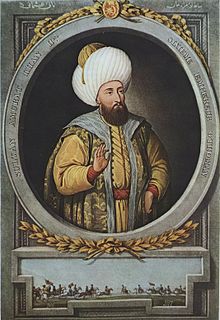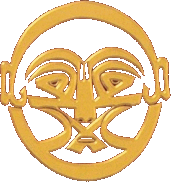
Ahmed I was the Sultan of the Ottoman Empire from 1603 until his death in 1617. Ahmed's reign is noteworthy for marking the end of the Ottoman tradition of royal fratricide; henceforth Ottoman rulers would no longer execute their brothers upon accession to the throne. He is also well known for his construction of the Blue Mosque, one of the most famous mosques in Turkey.

Murad II was the Ottoman Sultan from 1421 to 1444 and 1446 to 1451.

The Ottoman dynasty was made up of the members of the imperial House of Osman, also known as the Ottomans. According to Ottoman tradition, the family originated from the Kayı tribe branch of the Oghuz Turks, under Osman I in northwestern Anatolia in the district of Bilecik Söğüt. The Ottoman dynasty, named after Osman I, ruled the Ottoman Empire from c. 1299 to 1922.

Edirne[eˈdiɾne] or Odrin is a city in the northwestern Turkish province of Edirne in the region of East Thrace, close to Turkey's borders with Greece and Bulgaria. Edirne served as the third capital city of the Ottoman Empire from 1369 to 1453, before Constantinople became the empire's fourth and final capital between 1453 and 1922. The city's estimated population in 2014 was 165,979.
Albania was ruled by the Ottoman Empire in different periods from 1480 to 1912. Ottoman rule began in 1479, after the fall of Shkodra. The Albanians revolted again in 1481 but the Ottomans finally controlled Albania by 1488. The Ottomans had previously ruled some Albanian regions after the Battle of Savra in 1385. The Ottomans placed garrisons throughout southern Albania by 1418 and established formal jurisdiction in central Albania by 1431. Even though The Ottomans claimed rule of all Albanian lands, most Albanian ethnic territories were still governed by Albanian Princes who were free of Ottoman rule. In 1431 Many Albanian Princes including Gjergj Arianiti, Zenevisi family and Gjon Kastrioti started a war against the Ottoman Empire which resulted in defeat of Gjon Kastrioti but victory in 5 battles for Gjergj Arianiti. These Albanian victories opened the way for the coming of Skanderbeg in 1443 in Kruja. Independence for most of the Albanian regions was maintained during 1443-1479, with the uprising under the lead of Skanderbeg. The Albanian resistance and war against Ottomans continued for 37 years. The last towns captured by the Ottomans were Shkodër in 1479 and Durrës in 1501. A period of the semi independence started in 1750s with the Independent Albanian Pashas. In 1754 the autonomous Albanian Pashalik of Bushati dynasty would be established with center the city of Shkodra called Pashalik of Shkodra. Later on the same autonomous Pashalik of Berat would be established and culminating with the Albanian Pashalik of Ali Pashe Tepelena in 1787. Albanian Pashaliks would end in 1831 with the last one being the Bushati Pashalik. Albanians would enter later on in the 16th and 17th centuries a period of Islamization. The territory which today belongs to the Republic of Albania remained part of the Ottoman Empire until it declared independence in 1912, during the Balkan Wars.

Bektashi Order or Shī‘ah Imāmī Alevī-Bektāshī Ṭarīqah is a Sufi dervish order (tariqat) named after the 13th century Alevi Wali (saint) Haji Bektash Veli from Khorasan, but founded by Balım Sultan. The order, whose headquarters is in Tirana, Albania, is mainly found throughout Anatolia and the Balkans, and was particularly strong in Albania, Bulgaria, and among Ottoman era Greek Muslims from the regions of Epirus, Crete and Macedonia. However, the Bektashi order does not seem to have attracted quite as many adherents from among Bosnian Muslims, who tended to favor more mainstream Sunni orders such as the Naqshbandiyya and Qadiriyya. The order represents the official ideology of Bektashism.

The Karamanids or Karamanid dynasty, also known as the Principality of Karaman and Beylik of Karaman, was one of the Islamic Anatolian beyliks, centered in south-central Anatolia around the present-day Karaman Province. From the 13th century until its fall in 1487, the Karamanid dynasty was one of the most powerful Turkish beyliks in Anatolia.
Hurufism was a Sufi doctrine based on the mysticism of letters (ḥurūf), which originated in Astrabad and spread to areas of western Persia and Anatolia in the late 14th–early 15th century.

Haji Bektash Veli or Ḥājī Baktāš Walī was an Alevi Muslim mystic, saint, Sayyid, humanist, and philosopher, who lived from 1209 to 1271. He lived and taught from approximately 1209 to 1271 in Anatolia. He is revered among Alevis for an Islamic understanding that is esoteric (spiritual), rational, progressive and humanistic. Alevi and Bektashi Muslims believe the path of Haji Bektash is the path of ʿAli ibn Abu Talib, since Ali was the source of Bektash's teachings. His original name was "Sayyid Muhammad ibn Sayyid Ibrāhim Ātā". He was one of the figures who flourished in the Sultanate of Rum and had an important influence on the Turkish nomads of Asia Minor. He is also referred to as the Sultan of Hearts and the Derwish of the Derwishes. Haji Bektash Veli was a descendant of Musa Kazim, the Seventh Imam of the Athnā‘ashariyyah Shi'a Muslim sect.

Ali Vâsib was an Ottoman prince. From 1977 to his death in 1983, he was the 41st head of the Imperial House of Osman, an Ottoman royal dynasty. Much of his life was spent in exile. If reigning, he would have been Sultan Ali I.

Fakhri Pasha or Fahreddin Pasha, known as Ömer Fahrettin Türkkan after the Surname Law of 1934, was the commander of the Ottoman Army and governor of Medina from 1916 to 1919. He was nicknamed "The Lion of the Desert" and "The Tiger of the Desert" by the British and Arabs for his patriotism in Medina and is known for defending Medina in the Siege of Medina during World War I.

The Arabati Baba Tekḱe is a tekḱe located in Tetovo, Republic of Macedonia. The tekke was originally built in 1538 around the türbe of Sersem Ali Baba, an Ottoman dervish. In 1799, a waqf provided by Recep Paşa established the current grounds of the tekke. The finest surviving Bektashi monastery in Europe, the sprawling complex features flowered lawns, prayer rooms, dining halls, lodgings and a great marble fountain inside a wooden pavilion.

Sari Saltik was a 13th-century Aelvi Turkish dervish, venerated as a saint by the Bektashis in the Balkans and parts of Middle East as well as the mainstream Sunni Muslim community.

Otman Baba was a 15th-century dervish who traveled throughout the Ottoman Empire, acquiring a following among heterodox Muslims in Bulgaria after 1445 that has developed into his veneration as a saint. After Otman Baba's death, a pilgrimage complex grew around his grave in the present-day Bulgarian village of Teketo, which was made a museum during communism. The hagiography of Otman Baba, written by his disciple Küçük Abdal and regarded by his followers as a canonical text, maintains that Otman Baba performed miracles that proved his superiority to other dervishes and Ottoman authorities, particularly Sultan Mehmed II. Straying from orthodox Islamic tenets, Otman Baba asserted his unity with God and his mastery of divine secrets—as the embodiment of monotheistic religious figures such as Muhammad, Jesus, and Moses.

Balım Sultan was a Bektashi sufi who established and codified the Bektashi Order at the beginning of the 16th century. The mystical practices and rituals of the Bektashi were systematized and structured by Balım, after which many of the order's distinct practices and beliefs took shape. He is considered the primary personality in the Bektashi Order after Hacı Bektaş-ı Veli (Haji Bektash) and is regarded as the “Second Pir”.

The Ottoman persecution of Alevis is best known in connection with the Ottoman sultan Selim I's reign (1512–1520) and his war against the Safavids in 1514. But there are examples that indicate that there already existed problems with Alevi-like groups in the Ottoman Empire since the 14th century.
The Albanian community in Egypt started by Ottoman rulers and military personnel appointed in the Egyptian province. A substantial community would grow up later by soldiers and mercenaries who settled in the second half of the 18th century and made a name for themselves in the Ottoman struggle to expel French troops in 1798–1801. Muhammad Ali (1769–1849) founded the Albanian dynasty of Egypt which lasted there until 1952. In the 19th and early 20th centuries, many other Albanians settled into Egypt for economical and political reasons. With the fedayeen, Muslim Brotherhood, and the culminating Egyptian Revolution of 1952 the Albanian community in Egypt diminished.














